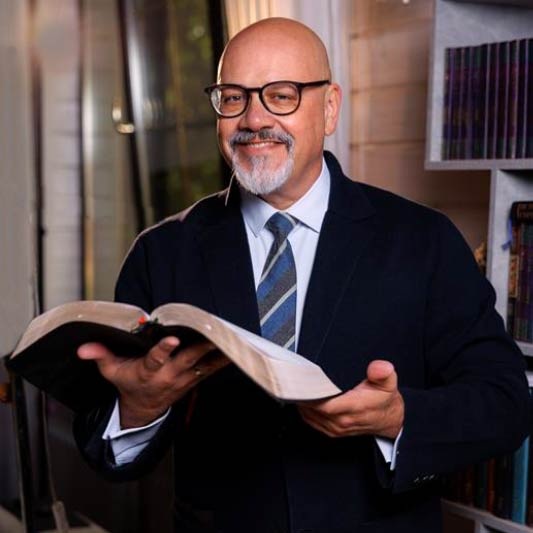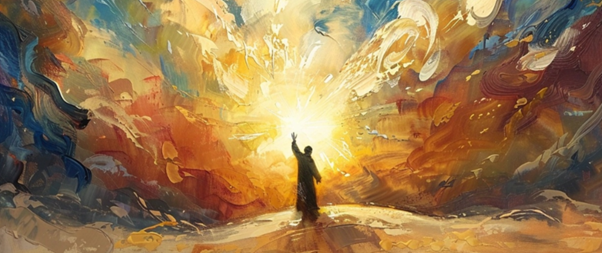The Torah employs a remarkable literary device known as chiasm, a structure that arranges words, phrases, or thematic elements in a mirrored pattern to emphasize meaning and create a sense of symmetry. In this structure, the text presents a sequence of ideas or events and then revisits them in reverse order, forming a kind of literary palindrome. This technique, often represented as A, B, C … C’, B’, A’, highlights the text’s intricate design and underscores its holistic nature. By analyzing the use of chiasm in biblical narratives, we uncover layers of meaning that might otherwise remain hidden. In the story of Noah and the flood (Genesis 6-9), while most readers focus on the salvation of humanity and animals through the ark, the chiastic structure suggests that the true heart of this ancient Hebrew narrative lies elsewhere. Could it be that we have overlooked the central message of this story?
The Chiastic Structure: A Literary Mirror
Chiasm derives its name from the Greek letter chi (Χ), which visually resembles the crossing or mirroring pattern of the structure. In a chiastic arrangement, thematic or narrative elements are paired symmetrically around a central point. These pairs are often denoted as A and A’, B and B’, and so forth, with the central element (lacking a parallel) serving as the climax or focal point of the narrative. The story of Noah in Genesis 6-9 exemplifies this structure, unfolding in a carefully crafted sequence that builds toward a pivotal moment in Genesis 8:1. This central verse, where “God remembers Noah,” stands as the theological and literary apex of the narrative, surrounded by mirrored elements that reinforce its significance.
To illustrate this, consider the thematic chiasm of Genesis 6-9, which can be outlined as follows:
A Noah introduced (6:10a)
__B Shem, Ham, and Japheth, Noah’s sons (6:10b)
___C Ark to be built (6:14-16)
____D Flood announced (6:17)
_____E Covenant with Noah (6:18-20)
______F Food stored in the ark (6:21)
_______G Command to enter the ark (7:1-3)
________H 7 days waiting for the flood (7:4-5)
_________I 7 days waiting for the flood (7:7-10)
__________J Entry to the ark (7:11-15)
___________K The LORD (YHWH) shuts Noah in (7:16)
____________L 40 days of flood (7:17a)
_____________M Waters increase (7:17b-18)
______________N Mountains covered (7:19-20)
_______________O 150 days: waters prevail (7:21-24)
________________P GOD REMEMBERS NOAH (8:1)
_______________O’ 150 days: waters abate (8:3)
______________N’ Mountain tops become visible (8:4-5)
_____________M’ Waters abate (8:5)
____________L’ 40 days (end of) (8:6a)
___________K’ Noah opens the window of the ark (8:6b)
__________J’ Raven and dove leave the ark (8:7-9)
_________I’ 7 days waiting for waters to subside (8:10-11)
________H’ 7 days waiting for waters to subside (8:12-13)
_______G’ Command to leave the ark (8:15-17 [22])
______F’ Food outside the ark (9:1-4)
_____E’ Covenant with all flesh (9:8-10)
____D’ No flood in the future (9:11-17)
___C’ Ark left (9:18a)
__B’ Shem, Ham, and Japheth (9:18b)
A’ Noah reintroduced (9:19)
__B Shem, Ham, and Japheth, Noah’s sons (6:10b)
___C Ark to be built (6:14-16)
____D Flood announced (6:17)
_____E Covenant with Noah (6:18-20)
______F Food stored in the ark (6:21)
_______G Command to enter the ark (7:1-3)
________H 7 days waiting for the flood (7:4-5)
_________I 7 days waiting for the flood (7:7-10)
__________J Entry to the ark (7:11-15)
___________K The LORD (YHWH) shuts Noah in (7:16)
____________L 40 days of flood (7:17a)
_____________M Waters increase (7:17b-18)
______________N Mountains covered (7:19-20)
_______________O 150 days: waters prevail (7:21-24)
________________P GOD REMEMBERS NOAH (8:1)
_______________O’ 150 days: waters abate (8:3)
______________N’ Mountain tops become visible (8:4-5)
_____________M’ Waters abate (8:5)
____________L’ 40 days (end of) (8:6a)
___________K’ Noah opens the window of the ark (8:6b)
__________J’ Raven and dove leave the ark (8:7-9)
_________I’ 7 days waiting for waters to subside (8:10-11)
________H’ 7 days waiting for waters to subside (8:12-13)
_______G’ Command to leave the ark (8:15-17 [22])
______F’ Food outside the ark (9:1-4)
_____E’ Covenant with all flesh (9:8-10)
____D’ No flood in the future (9:11-17)
___C’ Ark left (9:18a)
__B’ Shem, Ham, and Japheth (9:18b)
A’ Noah reintroduced (9:19)
This structure reveals a deliberate and symmetrical arrangement, with each element carefully paired with its counterpart. The progression from A to P and back to A’ creates a narrative arc that draws attention to the central moment, emphasizing its theological weight.
The Central Element: God Remembers Noah
The heart of the chiasm is found in Genesis 8:1, which reads in Hebrew:
וַיִּזְכֹּר אֱלֹהִים אֶת־נֹחַ וְאֵת כָּל־הַחַיָּה וְאֶת־כָּל־הַבְּהֵמָה אֲשֶׁר אִתּוֹ בַּתֵּבָה וַיַּעֲבֵר אֱלֹהִים רוּחַ עַל־הָאָרֶץ וַיָּשֹׁכּוּ הַמָּיִם׃
Translated, this verse states:
God remembered Noah and all the beasts and all the cattle that were with him in the ark, and God caused a wind to blow across the earth, and the waters subsided. (Gen 8:1)
This verse serves as the fulcrum of the entire narrative. In a chiasm, the central element is the point of greatest emphasis, the moment where the story’s deepest meaning is revealed. Here, the phrase “God remembered Noah” is not merely a narrative detail but a profound theological statement. The Hebrew verb zakar (“to remember”) carries connotations of active attention and covenantal faithfulness, implying that God turns toward Noah with mercy and purpose. This moment marks the transition from judgment (the flood) to restoration (the subsiding of the waters), encapsulating the triumph of divine mercy over divine wrath.
Theological Significance of the Central Moment
The centrality of Genesis 8:1 underscores a key theme in the Noah narrative: God’s faithfulness to His creation. While the flood represents divine judgment on human wickedness (Gen 6:5-7), God’s act of remembering Noah signals His commitment to preserving life. This moment is not only about Noah’s personal salvation but also about the broader covenantal relationship between God and all living creatures. The inclusion of “all the beasts and all the cattle” in Genesis 8:1 highlights the scope of God’s care, extending beyond humanity to the entire created order.
This theme of divine remembrance resonates throughout the Torah. For example, in Genesis 19:29, God remembers Abraham, sparing Lot from the destruction of Sodom. Similarly, in Exodus 2:23-25, God remembers His covenant with Abraham, Isaac, and Jacob, responding to the Israelites’ cries in Egypt and initiating their deliverance. These parallels suggest that the Noah story is part of a larger biblical motif of God’s redemptive memory. In each case, divine remembrance marks a turning point where judgment gives way to mercy, and destruction is followed by renewal.
In the context of the flood narrative, Genesis 8:1 also evokes the imagery of creation. The phrase “God caused a wind to blow across the earth” recalls Genesis 1:2, where the Spirit (or wind, ruach) of God hovers over the waters. This parallel suggests that the subsiding of the flood is a kind of re-creation, a renewal of the earth after the chaos of judgment. The chiastic structure reinforces this by placing the moment of divine remembrance at the center, framing it as the pivot between chaos and restoration.
The Broader Chiastic Framework
The mirrored elements surrounding Genesis 8:1 reinforce the narrative’s themes of judgment, preservation, and renewal. For instance, the announcement of the flood (D) is paired with the promise of no future flood (D’), highlighting God’s shift from judgment to grace. The covenant with Noah (E) finds its counterpart in the covenant with all flesh (E’), expanding the scope of God’s promise. The increasing waters (M) and their abatement (M’) mirror the rise and fall of the flood, while the covering of the mountains (N) and the visibility of mountain tops (N’) symbolize the reversal of destruction.
Even the smaller details, such as the seven-day waiting periods (H, I, H’, I’), reflect the careful symmetry of the narrative. These periods of waiting underscore the patience and trust required of Noah, culminating in the divine act of remembrance that initiates the restoration process. Similarly, the LORD shutting Noah in (K) is mirrored by Noah opening the ark’s window (K’), symbolizing the transition from divine protection to human agency in the renewed world.
Conclusion: The Heart of the Story
The chiastic structure of Genesis 6-9 reveals that the story of Noah is not primarily about the ark, the animals, or even the flood itself. Instead, the narrative’s heart lies in Genesis 8:1, where God remembers Noah and all living creatures. This moment encapsulates the triumph of divine mercy over judgment, a theme that reverberates through the Torah and beyond. By placing this act of remembrance at the center of the chiasm, the text invites readers to see God’s faithfulness as the foundation of hope and renewal. Far from being a mere survival story, the Noah narrative is a profound testament to God’s enduring commitment to His creation, a message that remains as relevant today as it was in ancient times.






SUPPORT AND GIVE
May the Lord bless you and keep you!
COUNT ME IN